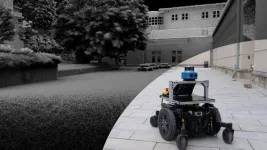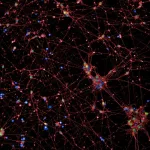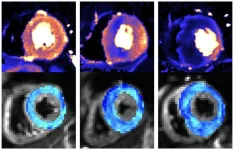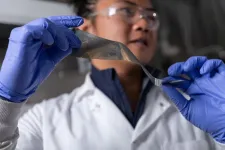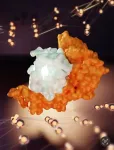(Press-News.org) A research group in Carnegie Mellon University's Robotics Institute is creating the next generation of explorers — robots.
The Autonomous Exploration Research Team has developed a suite of robotic systems and planners enabling robots to explore more quickly, probe the darkest corners of unknown environments, and create more accurate and detailed maps. The systems allow robots to do all this autonomously, finding their way and creating a map without human intervention.
"You can set it in any environment, like a department store or a residential building after a disaster, and off it goes," said Ji Zhang, a systems scientist in the Robotics Institute. "It builds the map in real-time, and while it explores, it figures out where it wants to go next. You can see everything on the map. You don't even have to step into the space. Just let the robots explore and map the environment."
The team has worked on exploration systems for more than three years. They've explored and mapped several underground mines, a parking garage, the Cohon University Center, and several other indoor and outdoor locations on the CMU campus. The system's computers and sensors can be attached to nearly any robotic platform, transforming it into a modern-day explorer. The group uses a modified motorized wheelchair and drones for much of its testing.
Robots can explore in three modes using the group's systems. In one mode, a person can control the robot's movements and direction while autonomous systems keep it from crashing into walls, ceilings or other objects. In another mode, a person can select a point on a map and the robot will navigate to that point. The third mode is pure exploration. The robot sets off on its own, investigates the entire space and creates a map.
"This is a very flexible system to use in many applications, from delivery to search-and-rescue," said Howie Choset, a professor in the Robotics Institute.
The group combined a 3D scanning lidar sensor, forward-looking camera and inertial measurement unit sensors with an exploration algorithm to enable the robot to know where it is, where it has been and where it should go next. The resulting systems are substantially more efficient than previous approaches, creating more complete maps while reducing the algorithm run time by half.
The new systems work in low-light, treacherous conditions where communication is spotty, like caves, tunnels and abandoned structures. A version of the group's exploration system powered Team Explorer, an entry from CMU and Oregon State University in DARPA's Subterranean Challenge. Team Explorer placed fourth in the final competition but won the Most Sectors Explored Award for mapping more of the route than any other team.
"All of our work is open-sourced. We are not holding anything back. We want to strengthen society with the capabilities of building autonomous exploration robots," said Chao Cao, a Ph.D. student in robotics and the lead operator for Team Explorer. "It's a fundamental capability. Once you have it, you can do a lot more."
The group's most recent work appeared in Science Robotics, which published "Representation Granularity Enables Time-Efficient Autonomous Exploration in Large, Complex Worlds" online this week. Past work has received top awards at prestigious robotics conferences. "TARE: A Hierarchical Framework for Efficiently Exploring Complex 3D Environments" won the Best Paper and Best Systems Paper awards at the Robotics Science and Systems Conference in 2021. It was the first time in the conference's history that a paper received both awards. "FAR Planner: Fast, Attemptable Route Planner Using Dynamic Visibility Update" won the Best Student Paper Award at the International Conference on Intelligent Robots and Systems in 2022.
More information is available on the group's website.
END
Enabling autonomous exploration
Carnegie Mellon University researchers design systems allowing robots to explore on their own
2023-07-19
ELSE PRESS RELEASES FROM THIS DATE:
More than just lifestyle and genes: New factor influencing excess body weight discovered
2023-07-19
What determines whether we become overweight? Aside from lifestyle, predisposition plays a role, but genes cannot fully explain the inherited propensity to accumulate excess weight. A new study by Charité – Universitätsmedizin Berlin in Science Translational Medicine* shows that a kind of formatting of the DNA code in one gene that is associated with satiety is implicated in a slightly elevated risk of excess body weight – at least in women. This “epigenetic marking” is established early on during the embryonic stage.
People who are overweight, especially those who ...
Fighting brain cancer
2023-07-19
“Don’t eat me!” That’s how one might translate the signal that the cancer cells in a glioblastoma send to the macrophages (white blood cells specialized in removing dead and dying cellular matter) in the brain. Immunotherapy attempts to enable these cells to eradicate the abnormal cells, but so far, it has met with little success when it comes to glioblastomas.
Researchers led by Professor Gregor Hutter from the Department of Biomedicine at the University and University Hospital Basel have recently used patient data, experiments with mice, and samples from human tumors to study one of these “don’t eat me!” signals and its inhibitory ...
New scanning methods can detect deadly heart condition before symptoms appear
2023-07-19
The research, funded by the British Heart Foundation and published in the journal Circulation, opens the prospect of treating the condition at the earliest stages.
Being able to detect HCM earlier than ever before will also assist trials investigating gene therapies and drug treatments aimed at stopping the disease developing in those at risk.
HCM is an inherited condition that affects around 1 in 500 people in the UK. It causes the muscular walls of the heart to become thicker than normal, affecting how well the heart can pump blood around the body. It is ...
Why ongoing worker safety training is critical to effective disaster response
2023-07-19
When it comes to disaster response and recovery operations, it is crucial that workers are prepared before there is an emergency, according to Rutgers researchers.
Their study, published in New Solutions: A Journal of Environmental and Occupational Health Policy, outlines the importance of the Worker Training Program to United States emergency and disaster-response infrastructure.
"It is essential to identify and deliver core disaster training to responders and workers on a routine basis prior to an [emergency] event," said Mitchel Rosen, an associate professor at the Rutgers School of Public Health. “The failure ...
MD Anderson research highlights for July 19, 2023
2023-07-19
HOUSTON ― The University of Texas MD Anderson Cancer Center’s Research Highlights showcases the latest breakthroughs in cancer care, research and prevention. These advances are made possible through seamless collaboration between MD Anderson’s world-leading clinicians and scientists, bringing discoveries from the lab to the clinic and back.
Recent developments include promising results from combining immunotherapy with radiation for non-small cell lung cancer (NSCLC), a novel combination therapy for secondary and treatment-resistant ...
Aluminum materials show promising performance for safer, cheaper, more powerful batteries
2023-07-19
A good battery needs two things: high energy density to power devices, and stability, so it can be safely and reliably recharged thousands of times. For the past three decades, lithium-ion batteries have reigned supreme — proving their performance in smartphones, laptops, and electric vehicles.
But battery researchers have begun to approach the limits of lithium-ion. As next-generation long-range vehicles and electric aircraft start to arrive on the market, the search for safer, cheaper, and more powerful ...
Noninvasive method for vagus nerve stimulation shows promise for enhancing motor rehabilitation after stroke
2023-07-19
The longest nerve in the human body starts in the brain and meanders its way down the neck and into the chest, where it splits into separate branches, winding its twisting tendrils to touch each internal organ. Known as the “information superhighway” and aptly named from the Latin word meaning “wanders,” the vagus nerve is a bundle of fibers responsible for the parasympathetic nervous system: digestion, heart rate, breathing.
Sending electrical impulses down this tenth cranial nerve has proven effective in treating conditions like depression and epilepsy, ...
Dedicated older people’s emergency department reduces wait times
2023-07-19
The formation of the country’s first emergency department for the over 80s led to a significant decrease in time spent in A&E – according to research from the Norfolk and Norwich University Hospital (NNUH) and University of East Anglia (UEA).
The first Older People’s Emergency Department in England was opened at NNUH in December 2017 to bring specialists in older people’s medicine to the front doors of the hospital and provide earlier assessment and treatment for patients.
A new study evaluates the outcomes for patients who received treatment in the main emergency department at NNUH and a similar ...
Genetics explains why some individuals never have COVID-19 symptoms
2023-07-19
Have you ever wondered why some people never became sick from COVID-19? A study published today in Nature shows that common genetic variation among people is responsible for mediating SARS-CoV-2 asymptomatic infection. The results indicate that individuals having this variant never feel sick once infected. This exciting discovery was a result of a U.S.-Australia collaborative work led by Danillo Augusto, Ph.D., assistant professor at the University of North Carolina at Charlotte; Jill Hollenbach, Ph.D., professor ...
Unveiling the quantum dance: Experiments reveal nexus of vibrational and electronic dynamics
2023-07-19
Nearly a century ago, physicists Max Born and J. Robert Oppenheimer developed an assumption regarding how quantum mechanics plays out in molecules, which are comprised of intricate systems of nuclei and electrons. The Born-Oppenheimer approximation assumes that the motion of nuclei and electrons in a molecule are independent of each other and can be treated separately.
This model works the vast majority of the time, but scientists are testing its limits. Recently, a team of scientists demonstrated the breakdown ...
LAST 30 PRESS RELEASES:
Reviving dormant immunity: Millimeter waves reprogram the immunosuppressive microenvironment to potentiate immunotherapy without obvious side effects
Safety decision-making for autonomous vehicles integrating passenger physiological states by fNIRS
Fires could emit more air pollution than previously estimated
A new way to map how cells choose their fate
Numbers in our sights affect how we perceive space
SIMJ announces global collaborative book project in commemoration of its 75th anniversary
Air pollution exposure and birth weight
Obstructive sleep apnea risk and mental health conditions among older adults
How talking slows eye movements behind the wheel
The Ceramic Society of Japan’s Oxoate Ceramics Research Association launches new international book project
Heart-brain connection: international study reveals the role of the vagus nerve in keeping the heart young
Researchers identify Rb1 as a predictive biomarker for a new therapeutic strategy in some breast cancers
Survey reveals ethical gaps slowing AI adoption in pediatric surgery
Stimulant ADHD medications work differently than thought
AI overestimates how smart people are, according to HSE economists
HSE researchers create genome-wide map of quadruplexes
Scientists boost cell "powerhouses" to burn more calories
Automatic label checking: The missing step in making reliable medical AI
Low daily alcohol intake linked to 50% heightened mouth cancer risk in India
American Meteorological Society announces Rick Spinrad as 2026 President-Elect
Biomass-based carbon capture spotlighted in newly released global climate webinar recording
Illuminating invisible nano pollutants: advanced bioimaging tracks the full journey of emerging nanoscale contaminants in living systems
How does age affect recovery from spinal cord injury?
Novel AI tool offers prognosis for patients with head and neck cancer
Fathers’ microplastic exposure tied to their children’s metabolic problems
Research validates laboratory model for studying high-grade serous ovarian cancer
SIR 2026 delivers transformative breakthroughs in minimally invasive medicine to improve patient care
Stem Cell Reports most downloaded papers of 2025 highlight the breadth and impact of stem cell research
Oxford-led study estimates NHS spends around 3% of its primary and secondary care budget on the health impacts of heat and cold in England
A researcher’s long quest leads to a smart composite breakthrough
[Press-News.org] Enabling autonomous explorationCarnegie Mellon University researchers design systems allowing robots to explore on their own
